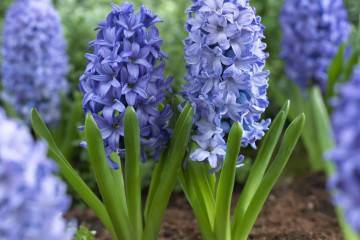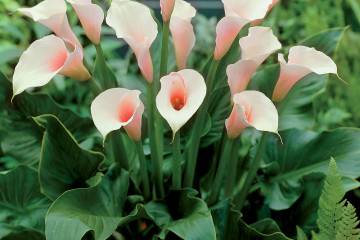Ifeion flowers - planting and care in the open field
Content:
Ifeion is a plant whose flowers resemble the shape of stars. Today there are more than 25 thousand species of ifaeon, but only one is used for cultivation on the site. The plant is native to the tropical regions of South America. A distinctive feature of the culture can be called elongated green leaves, rubbing which, a person smells garlic or onions.
Types and varieties of ifaeon
Ifeion one-flowered - the main plant variety, which served as the basis for the creation of more unique varieties. The flower is small. There are no shoots, so foliage blooms directly from the bulbs.
By the end of spring, the plant pleases with abundant flowering. First, a peduncle hatches from the leaves. It, in turn, is crowned with a large flower with a diameter of 30 mm. During the first year after planting, there are very few stars, but over time there are more of them.
The originators bred many varieties of ifeion. Flowers differ in color. The most popular plant varieties are:
- Ifeion Jessie;
- Wisley Blue;
- White Star.
Jessie ipheion is a dark blue flower that has been compared to a bell. The plant is practically indistinguishable from other varieties. It also grows 15-20 cm in height. Landscape designers often use Jesse's ifeion to create garden decorations.
In the description of the Jessie Ifeion flower, we can add that it has a long flowering. It is for this feature that summer residents love him. Moreover, it is not so difficult to grow it in the garden.
Features of growing ifheon in the open field
Many gardeners are wondering if it is possible for an Ifeion flower to plant and care in the open field. It is possible to cultivate a plant in a garden, but only in regions with a warm climate.
To land, you need to find an illuminated area. The space must be protected from cold winds and drafts. It is desirable that the soil is loose and fertile.
The bulbs should be planted in the ground, deepening them by a maximum of 5 cm. A gap of 8-10 cm is maintained between the flowers. The planted material is watered sparingly, periodically checking the moisture content of the soil. During flowering, the amount of water for irrigation is increased, after flowering, it is reduced.
At the end of summer, the plant is fertilized with substances based on natural minerals. Within 3 years, the bulbs will grow over the site, forming a floral carpet. To stop their growth a little, you need to transplant the bulbs.
Ifeion is a flower that loves warmth, so a shelter is being built for him. The plant is left to overwinter under a textile material, or under a special cap (lutrasil, spunbond).
Ifeion transplant - basic rules
If the ifeion was originally planted in a deep and wide pot, then it will need a transplant in a few years. In one spacious pot, the plant can live up to 5 years.
When a flower needs a transplant, it gives signals to its owner. First of all, the flowers of the plant become small, and over time they stop forming altogether. This means that too many bulbs have grown and do not have enough nutrients to grow.
Ifeion also needs a transplant if he has not been properly looked after. When a plant is infected with something, its leaves and bulbs begin to rot. For transplantation, a new spacious pot is used, in which a nutrient substrate and a drainage layer are placed. The plant is pulled out together with a lump of soil and transferred to another dish. Minimum watering is performed within 20-30 days after transplanting.
Pruning Ifeion Leaves
It is easy to care for the Ifeion uniflorum, since the plant itself is unpretentious. When the flower leaves turn yellow, do not cut them off. During this period, the culture begins to absorb all the nutrients for further growth. If you remove the yellowed parts of the flower, the bulb will stop ripening. Leaves are allowed to be removed immediately after they dry out.
Ifeion diseases and pests
Often a plant gets sick only because it is not properly cared for. If the gardener adheres to the watering and illumination regime, then no diseases will overtake the bush. Improperly selected soil, an abundance of moisture and an untimely transplant - all this can lead to a weakening of the planting.
Pests that can infect a plant include:
- Root mite - insects that eat the roots of a plant. Usually pests end up in the ground along with infected bulbs. First of all, the tick gnaws at its diseased parts, and then moves on to healthy ones. Ifeion stops blooming, and dries up over time.
- A spider mite is a small insect that cannot be seen with the naked eye. Harm feeds on the contents of plant cells. The disease is characterized by the appearance of white dots and a thin cobweb on the leaves. With severe damage, the foliage turns yellow, while the flower begins to dry out.
- Aphids are a small insect that is able to suck plant sap from ifeion leaves. In order to detect the pest in time, it is necessary to regularly inspect the plant. Damaging a flower, aphids leave small punctures on the stems and leaves. It releases a toxic poison that spreads through the plant by rolling the leaves. In addition, aphids are considered a carrier of dangerous diseases.
Constant observation of the plant will help you not to overlook the moment of occupation. If the infection does occur, it is necessary to treat the planting with insecticides.
In addition to pests, ifeion is afraid of root rot. Rotting can occur due to poor drainage or over-watering. If the Ifeion bulbs have begun to rot, they should be urgently dug up and transplanted to another place. Before planting, the excavated material is treated with a fungicide.
How to grow ifeion at home
Bulbs ready for planting are purchased from a specialized store. It is impossible to keep them without soil for a long time, so after purchasing it is worthwhile to immediately start planting. Several pieces are planted in a pot at once, since the width and thickness of the bulbs is about 1 cm. As soon as the plant begins to bloom, a lush and bright "bush" forms in the pot.
Within 3-4 weeks, the planting material begins to take root. The bulbs are gaining strength and strengthening. After another month, flowering begins. If you plant an ifeion in the fall, it will delight you with its beauty throughout the winter.
Ifeion is a light-loving plant, so the flower pot is installed on the south window.The sun shines through these windows almost all day. A few days after planting, the soil is watered. With the appearance of the first flowers, watering is slightly increased. Any water is allowed to be used. In addition, it is necessary to ensure that the soil is always moist.
Feeding is carried out at least once a year. To do this, use special fertilizers based on potassium or phosphorus. The culture will enter a dormant stage when all the leaves turn yellow. Further care of the plant consists in rare watering.
It is recommended to move the pot to a cool place and leave it there until the end of summer. In the fall, the ifeion is again put on a lighted windowsill and new shoots are awaited.
Ifeion breeding methods
The culture propagates by dividing the bulbs or seeds.
Bulbs
The first method is used in the process of plant transplanting - once every 3-4 years. The gardener begins to separate the children from the mother's bulb. After that, he transplants them into fertile light soil, which contains organic fertilizer. Already next season, a young plant will grow from the planted bulbs.
Seeds
It is difficult for novice gardeners to grow a plant by seed method, since the process requires special knowledge and skills. The seeds are harvested after ripening in mid-summer. After that, the planting material is placed in the refrigerator for several days for hardening.
The stratified seeds are planted in moist soil and covered with plastic or plastic wrap. The dishes are placed in a brightly lit place, while the temperature in the room should be in the range of 20-22 ° C.
A month later, the first shoots will begin to appear. As soon as the bulbs form 3-4 leaves, they are prepared for picking. After that, they start planting in open ground. The most favorable time for this is August and early September.
Propagated by seed, ifeons bloom for the first time after 3-4 years. In rare cases, this happens earlier.
Ifeion is a plant that can decorate the local area. Even novice gardeners can grow it. Despite the fact that some varieties are not yet common in Russia, every grower has the opportunity to become the owner of a "star" flower.





















